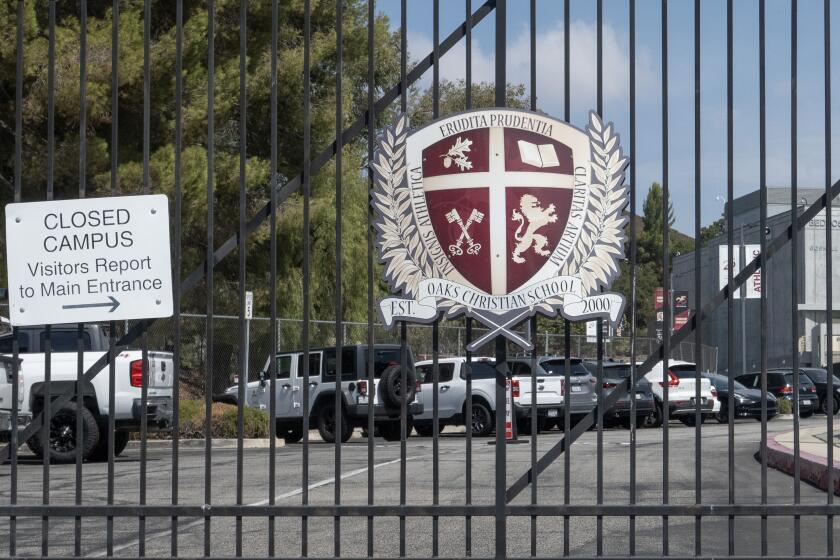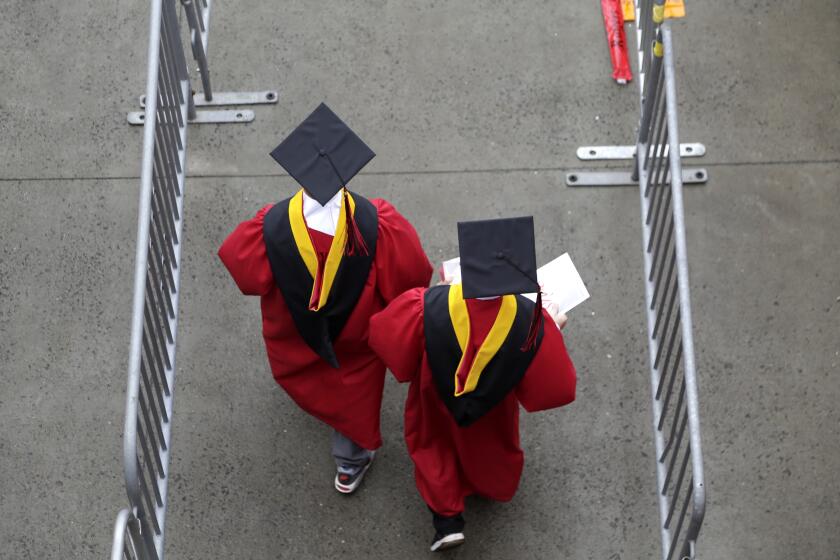Separate and Equal : O.C. Teachers Who Get Their Own Kids Try to Be Fair in the Classroom and Leave Parent Role at Home
Diane Goettsche, the Spanish teacher at Fairmont Private School in Anaheim, is known to all of her students as Senora Goettsche. However, one little girl has another name for her that she uses before and after school--Mom.
Goettsche, who has just begun her second year at Fairmont, has second-grade daughter Andrea in one of her classes, a situation she was a little apprehensive about before school began. “It did make me nervous to think that she’d be in my class. Of course, I had to try and not show any favoritism, but I also couldn’t be too hard on her either.”
So far, the arrangement appears to be working well. “The other students she went through first grade with have known her before they knew me, so I’m just another teacher who happens to be Andrea’s mom.”
The Goettsches’ school/work arrangement is not uncommon--particularly in private schools, where teachers often have the option of enrolling their children and smaller enrollments make it more likely that the child will at some point be placed in a class taught by his or her parent.
In public schools, the combination is less likely because the parent is typically not assigned to his or her neighborhood school and, in those cases where parent and child are at the same school, the larger number of classrooms per grade makes separate scheduling easier.
Issues of favoritism and independence are often raised when the roles of teacher and parent are blended in the classroom. But, say some school administrators and teachers who have had the experience, the blended relationship can and does work when everyone is sensitive to potential problems.
“Years ago it wasn’t looked at as very professional,” says Fred Burry, director of the Oak Ridge School, a private school that has campuses in Santa Ana, Orange and Coto de Caza. “People thought that having the parent around the school or teaching the class would put too much pressure on the child. But it creates a close, family atmosphere, not unlike that found in the old one-room schoolhouse.”
“My mother worked at the junior high I went to, and it was comforting knowing she was there,” says Teri Wright, Ph.D., a marriage, family and child counselor in Orange. “At the same time, she wasn’t a part of my school life, which was important.”
Wright points out that teacher/parents must walk a fine line to maintain their child’s school experience, because school is considered one of the first steps toward adulthood and separation from parents. “At home you have to be the parent, and at school you have to be the teacher. There has to be that diversity of roles.”
Goettsche, whose daughter Andrea is in her Spanish class, also daughter Lauren in Fairmont’s pre-kindergarten program. Goettsche and her daughters leave at 6:30 a.m. each weekday for the commute to school/work from their home in Corona. “The drive is about an hour each way, and we use it to talk about what’s going on at school and home. If Andrea has reading homework, she’ll read to me in the car. It’s really a close time for us.”
Deciding on whether to take the kids to school/work isn’t always easy. “Last year, after being here two months, we made the decision to pull Andrea from public school and enroll her at Fairmont,” Goettsche says.
While parent/teachers at private schools can often enroll their children in the schools where they work, they usually have to pay.
“We used to give our faculty and staff a discounted tuition,” says David Jackson, executive director of Fairmont, which has a yearly tuition ranging from $5,000 to $6,000 at its two campuses in Anaheim and one in Yorba Linda.
“However, many of the staff who didn’t have children at the school felt this was unfair, that the discount amounted to an increase in salary. Now, the staff is eligible to apply for financial aid like any other family in the school, and we’ll help the best we can.”
Keeping their children close by while they work is an arrangement many parents would like. For teachers, that is more possible than in many other professions.
“Originally, I was going to have my daughters go to public school and arrange some kind of day care when they got out,” says Jean McAlister, a third-grade teacher at Oak Ridge who has a daughter in the school’s eighth-grade class. Her oldest daughter is in high school after graduating from Oak Ridge last year.
“Taking them with me to work, being able to watch their progress in school and taking them home has been great,” McAlister says. “It’s saved me a lot of worry and transportation problems. I was able to concentrate fully on teaching during the day, and I didn’t have to be concerned about where they were or what they were doing.”
However, that ability to keep a watchful eye on your child can create problems.
“It’s good for kids to break free from their parents, and the parents need that break, too,” says Carol Barnes, Ph.D., who chairs the department of elementary and bilingual education at Cal State Fullerton. “Children need the chance to test their limits; they need to be themselves. If the parent is supervising the playground at recess, the child will probably behave differently since the parent will probably be watching them more closely.”
“My daughter has asked me not to chaperon any of the school dances,” McAlister says. “And that’s fine; I do what I can not to intrude on her school life. But that’s the same position any parent who’s active in the school would have.”
While having the teacher/parent and child together on campus can be difficult, it’s when they’re paired in the classroom that the relationship can become sticky. “As a mother who has been a teacher, I just don’t feel I could be impartial,” Barnes says. “I’d probably be too hard on my children, which isn’t fair.”
“I had one of my daughters in a summer school class, and it worked out fine,” McAlister says. “You have to be aware of the bias you may have and treat him or her just like the other kids whether you’re giving praise or discipline.”
“I think it depends a lot on the child’s personality,” says Kim Zeydel, a teacher at Oak Ridge who has taught both of her children in her classroom. “In my situation, it worked great during my math class. But later in the day, when they had me in an American government class, it was like, ‘Let’s see if we can get Mom ticked off today.’ But you work it out; you treat them like any other student.”
There’s also the issue of how a child’s behavior and performance in school reflect on the teacher/parent.
“Because you’re a teacher, you naturally wonder what your peers think of your child,” Goettsche says. “You want your child to be perceived in a good way.”
“It makes you think, but I believe every parent wonders how their children reflect on them,” McAlister says. “There were times when my children needed to be disciplined, and they were treated like any other student, which is what needs to be done. It may not make you feel good, but you’ve got to be an adult and not take it personally. You hope your child will be the ‘A’ student and good citizen, but you have to accept and love your child the way he or she is.”
The key to a successful teacher/parent and child relationship appears to be separating the two roles.
“I’d do anything I could not to interfere with my child’s teachers,” Barnes says. “You have to go into the situation professionally, as if you didn’t know your child’s teachers on a personal level. I’d also make an effort not to see my child during the school day; the other children don’t see their parents.”
Like any parent, a teacher/parent is interested in what goes on in the child’s classroom, and other teachers can be uncomfortable with having a colleague monitor their classroom.
Although Barnes never taught at the same schools her children attended, her children’s teachers were aware of what she did for a living. “I once looked up one of my child’s school records and found a note that said, ‘His mother’s a teacher, but she’s OK.’ ”
More to Read
Sign up for Essential California
The most important California stories and recommendations in your inbox every morning.
You may occasionally receive promotional content from the Los Angeles Times.










